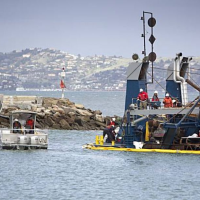State Appellate Court Halts Excessive Sand Mining in San Francisco Bay
 S.F. Bay sand barge (photo: Laura Morton)
S.F. Bay sand barge (photo: Laura Morton)
Although a fair amount of scientific research points to harm done by mining sand in the San Francisco Bay, the State Lands Commission said the dredging complied with the California Environmental Quality Act and granted a dozen 10-year leases in October 2012 to do it.
San Francisco Baykeeper, a nonprofit environmental group, sued the next month, arguing the commission had an obligation to look beyond the environmental report and consider the bay as a public trust resource that is protected from private degradation. On Wednesday, the California 1st District Court of Appeal agreed with the group (pdf) and overturned a lower-court decision.
After tracing the history of public trust doctrine back to Roman law, the appellate court conceded that there is no black and white way for the state to perform its duty to the public trust and “protect the people's common heritage of streams, lakes, marshlands and tidelands, surrendering that right of protection only in rare cases.”
But the court said the commission was under an obligation to try. The commission didn't make that assessment, and argued it didn't have to. The court summarized the state's reasoning:
“First, sand mining is indisputably a public trust use of sovereign land; second, even if the mining leases are not a public trust use, the public trust doctrine does not apply to mineral extraction leases which do not permanently alienate the trust res; and finally, CEQA review eliminates the obligation to consider whether a project violates the public trust.”
The court disagreed with all three arguments. The commission has to go through a process that considers a broader range of effects that sand mining is having.
Environmentalists argue that sand mining in the bay is ruining Ocean Beach to the south, affecting sand distribution all the way to Point San Pedro, and adversely affecting shellfish, bottom-dwelling invertebrates, juvenile Dungeness crab, sturgeon and other important Bay species.
At the core of the Baykeeper's lawsuit was a 2013 study in the journal Marine Geology that fleshed out the details. It was from a group made up mostly of scientists at the U.S. Geological Survey (USGS). It said the 10-mile stretch is eroding quicker than any other section of California coastline.
Sand miners need a lease agreement with the commission and a permit from the San Francisco Bay Conservation and Development Commission (BCDC) to do their work. Three companies extract sand from below Central San Francisco Bay, Suisun Bay and the western Sacramento-San Joaquin River Delta, which is used in Bay Area construction project.
Sand miners use suction dredges mounted on 200-foot barges to intercept sediment flowing down from the Sierras before it can pass through the Golden Gate Bridge on its way to coastal beaches. The commission concluded that the alternative, carting in sand from far away, would be at least as harmful to the environment.
‒Ken Broder
To Learn More:
Sand Mining in SF Bay Dealt Blow by State Appeals Court (by Laura Dudnick, San Francisco Examiner)
C.A. Overturns Approval of San Francisco Bay Sand Mining (by Kenneth Ofgang, Metropolitan News-Enterprise)
New Research Confirms Excessive Sand Mining in Bay Erodes Ocean Beach (San Francisco Baykeeper)
SF Bay Sand Mining Alarms Conservationists (by Nate Seltenrich, San Francisco Chronicle)
A Multi-Discipline Approach for Understanding Sediment Transport And Geomorphic Evolution in an Estuarine-Coastal System: San Francisco Bay (by P.L. Barnard, B.E. Jaffe and D.H. Schoellhamer, Marine Geology)
San Francisco Baykeeper Inc. v. California State Lands Commission (California Court of Appeal First Appellate District (pdf)
- Top Stories
- Controversies
- Where is the Money Going?
- California and the Nation
- Appointments and Resignations
- Unusual News
- Latest News
- California Forbids U.S. Immigration Agents from Pretending to be Police
- California Lawmakers Urged to Strip “Self-Dealing” Tax Board of Its Duties
- Big Oil’s Grip on California
- Santa Cruz Police See Homeland Security Betrayal in Use of Gang Roundup as Cover for Immigration Raid
- Oil Companies Face Deadline to Stop Polluting California Groundwater





